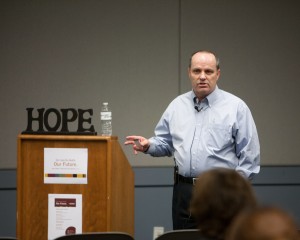
Suicide is the most preventable type of death, yet it takes the lives of more than 34,000 Americans every year.
“It’s not unusual to have second, third or fourth graders on suicide watch,” said Gregory A. Hudnall, the executive director of Hope 4 Utah. “On average, there is one death by suicide every fifteen minutes in this country.”
Provo residents, Utah County mental health organizations and various suicide support and awareness groups gathered at the Utah County Health and Justice Building on May 22 for a discussion on suicide prevention. Hudnall educated participants on how to recognize if someone may be suicidal and how to best help them if they are.
“Suicide prevention is everybody’s business, and anyone can help prevent the tragedy of suicide,” Hudnall said
Utah residents contemplate committing suicide more than people in any other state. Hudnall hopes to reduce this rate by raising awareness in the community about suicide prevention and offer hope and help to those who may be struggling.
Malisa Brooks, an Orem resident studying social work at Utah Valley University, attended the discussion to gain skills to help with her work as a volunteer at the Utah County Crisis Line.
“You can never know too much information when it comes to saving someone’s life,” Brooks said.
According to Brooks, one of the best ways to connect to someone who may be having suicidal thoughts is to meet them on their level and help them find a reason to go on.
“Everyone has a reason to live,” Brooks said. “We just help them find out what that is.”
Hudnall led participants through three components of QPR training at the meeting: questioning, persuading and referring. He also emphasized the importance of listening when trying to help someone.
“Listening can be lifesaving,” Hudnall said. “When someone asks you how you’re feeling when you’re struggling, it kicks in in your brain that someone cares about you.”
Stacey Hatfield, a Spanish Fork resident who serves as a board member on the Utah chapter of the American Foundation for Suicide Prevention, lost her brother three years ago to suicide.
“I like to come to these events and get information out there so people know there are people who care and help is available,” Hatfield said.
She said sometimes people who experience suicidal thoughts and depression may feel ashamed to ask for help. Events like the town hall discussion exist to educate people about how to offer support and to teach that mental illness is not something to be embarrassed about.
“Suicide is preventable, and there is hope and help out there for people who are struggling,” Hatfield said. “There’s no shame in asking for help.”
Hudnall ended his remarks by talking about Hope Squad, a program Hope 4 Utah is implementing in schools around the state to lower suicide rates. The program trains students to recognize signals that someone may be contemplating suicide and teaches them how to respond. There have been no suicides in the Provo school district since Hope Squad was implemented in 2005.
Provo resident Richard Smith lost his son to suicide. Hudnall was his son’s principal at the time.
“Greg lost almost as much as I lost when he passed,” Smith said. “I am very impressed to see these systems he helps with working hard to inform the community and to teach and inform them on how to help those in need.”
Hudnall opened the floor to the audience after the discussion for questions and comments. Amanda Shields, an Orem resident who serves as a facilitator for Heart and Soul suicide support group and as the chair for the Hope 4 Utah Walk 4 Hope, spoke about losing her brother right before he graduated from college.
Shields and her family attribute her brother’s decision to commit suicide to his fear about the future with graduation so close. She said she hopes college students who are struggling with similar fears and feelings of uncertainty will reach out and seek help.
“There are those who love you and who want to help you,” Shields said. “Find someone who can help you see hope and manage your feelings. Be willing to reach out — your future is worth it.”




